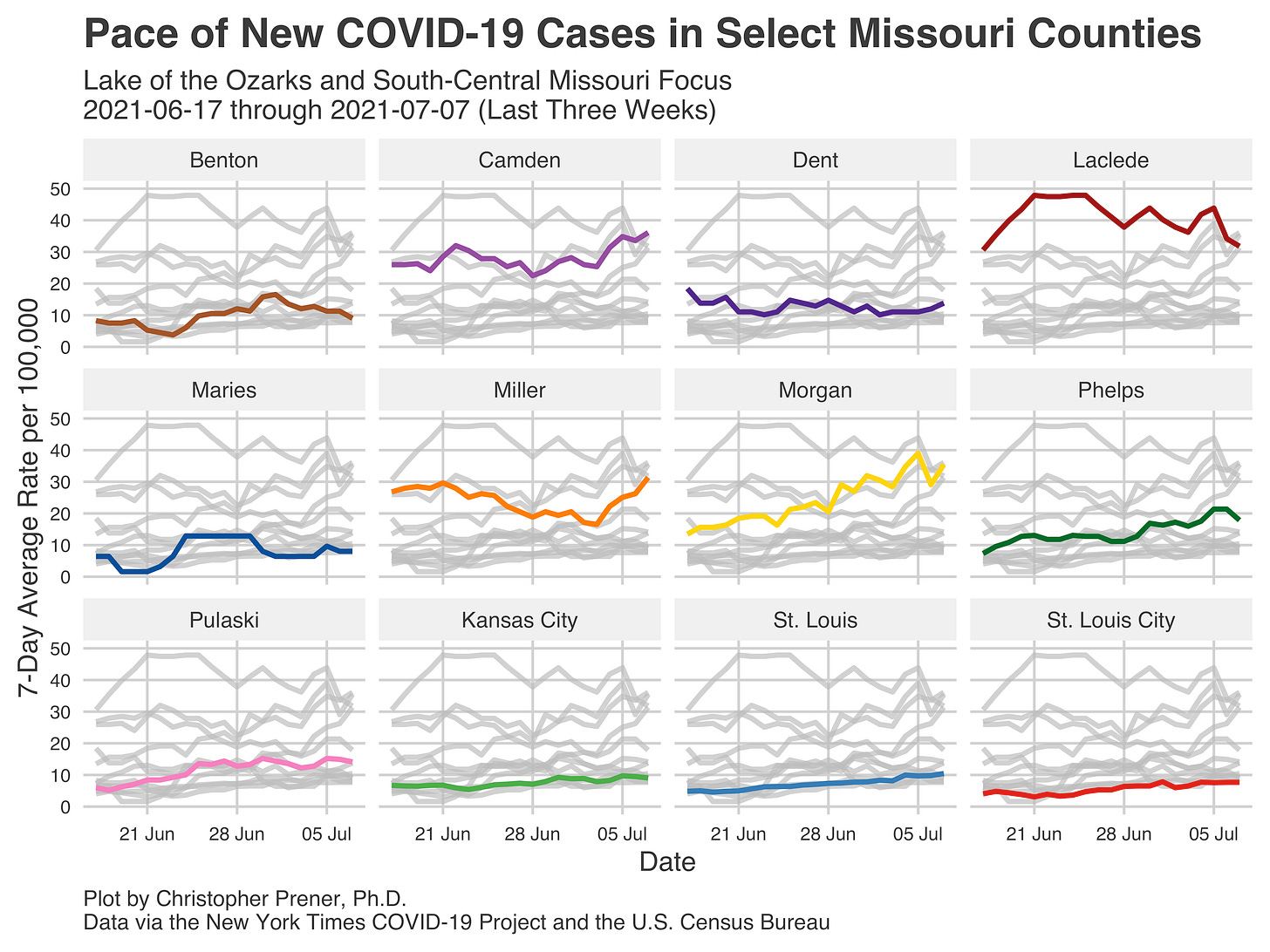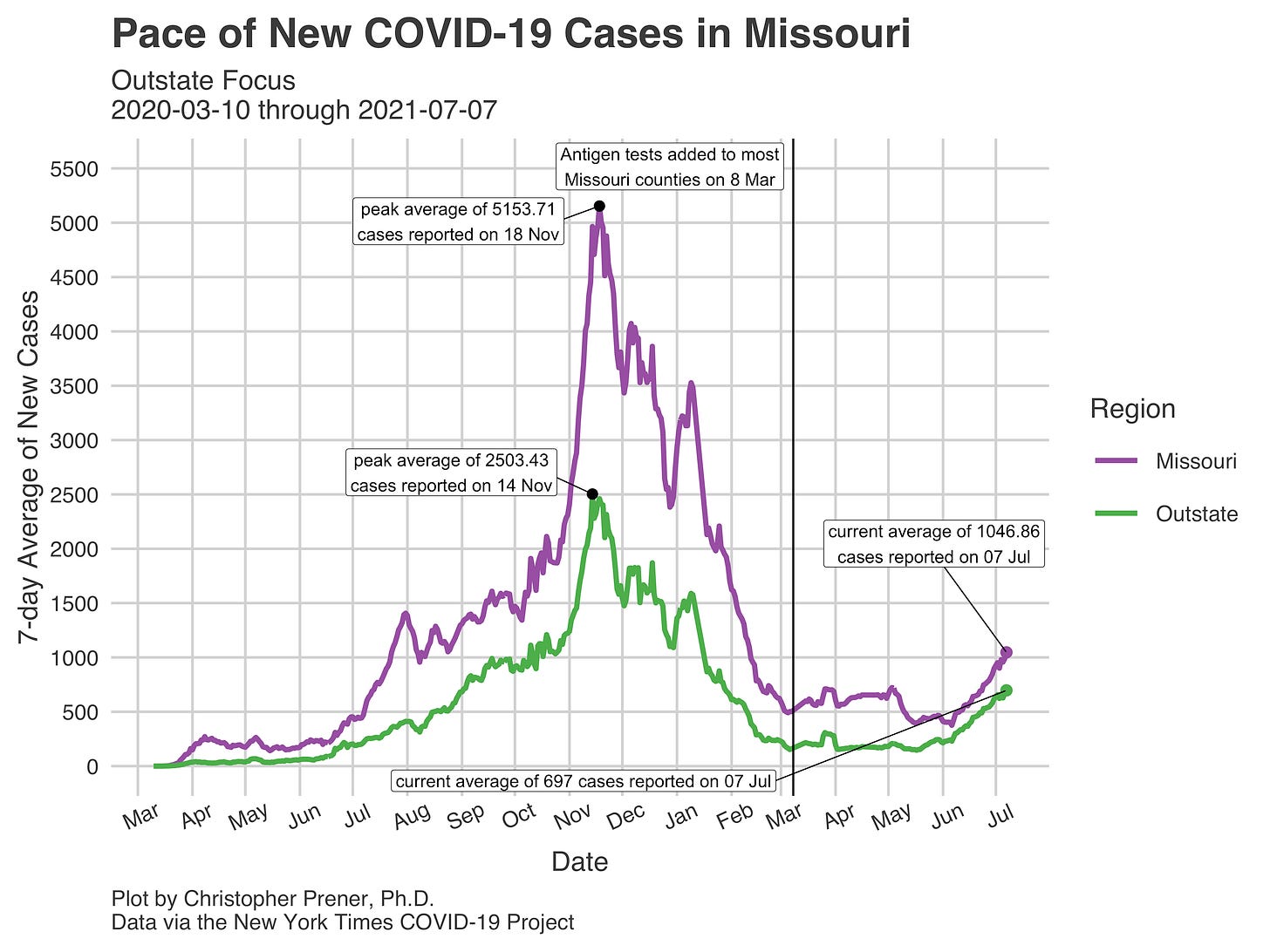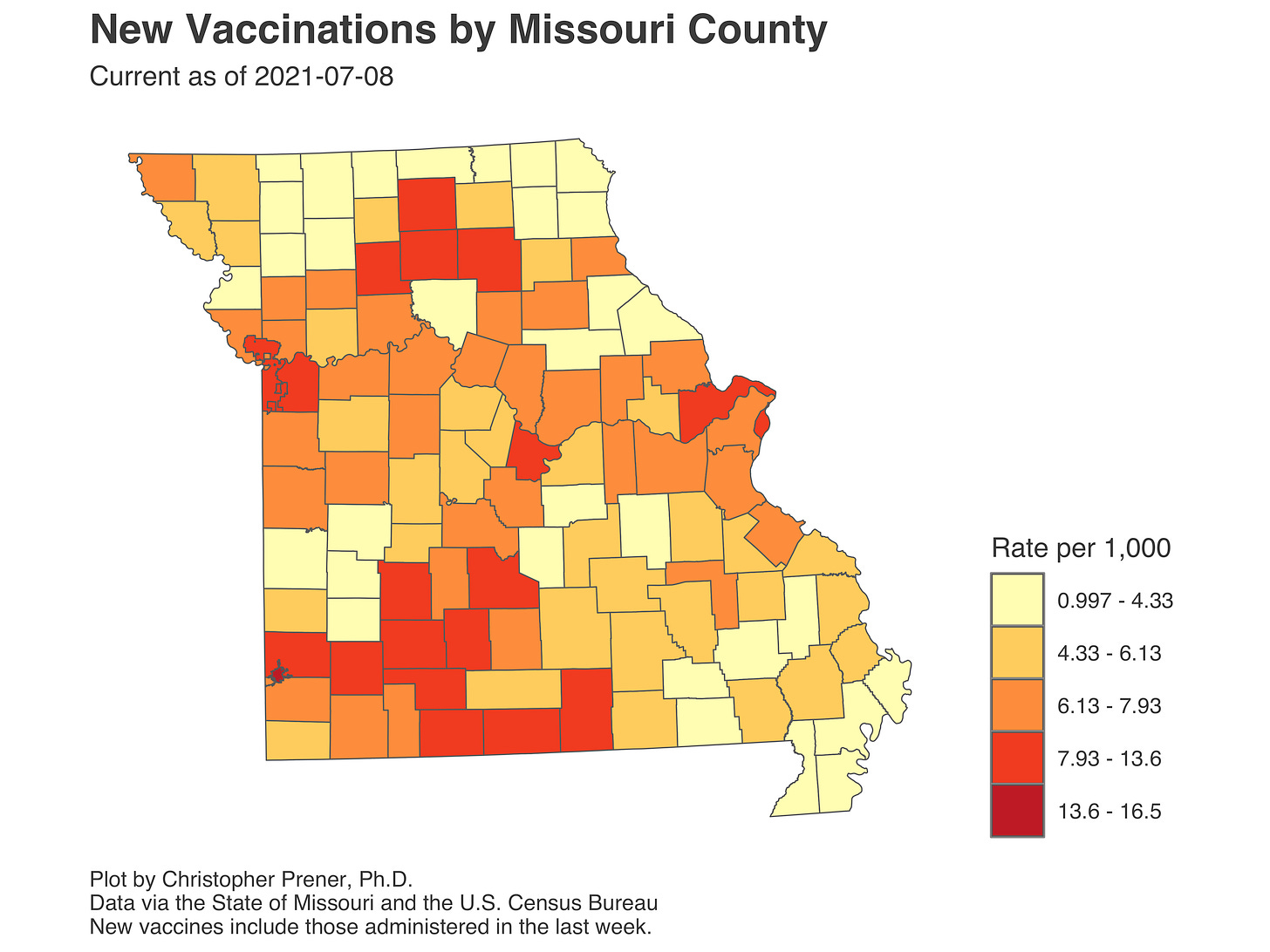After a week off (thanks for your patience!), I am back tonight with additional data showing a deepening crisis in Southwestern Missouri. Cases continue to rise there, hospitalizations are increasing, and the messages we hear from hospital leaders evoke March and April 2020.
I don’t mention it below, but we are also approaching a grim mortality milestone. Likely tomorrow or Saturday, we will cross the threshold of 10,000 Missourians having passed away from COVID-19. As Delta variant cases continue to rise, we are likely headed towards a period where the number of our neighbors who pass away grows at an increasing pace. - Chris
COVID-19 by the Numbers
Total cases in MO: 642,189 (+7,328 from last Thursday)
7-day average of new cases per day in MO: 1,046.86 (+148.43 from last Thursday)
Counties with the highest per capita rates (per 100,000) of new cases per day this past week:
Joplin (66.19 per 100,000), Taney (59.78), Gentry (53.58), Polk (52.98), Newton (51.92), Greene (49.33), Andrew (49.25), and Webster (48.39)
Total deaths in MO: 9,993 (+60 from last Thursday)
7-day average of new deaths per day in MO: 8.57 (-0.43 from last Thursday)
Percent of all Missourians initiating vaccination: at least 40% (+1% point from last Thursday)
Percent of all Missourians completing vaccination: at least 35% (+1% point from last Thursday)
Case and mortality numbers are current as of Wednesday, July 7th. Vaccination numbers are current as of Thursday, July 8th. Additional statistics, maps, and plots are available on my COVID-19 tracking site.
Illness Trends in the Past Week
Missouri continues to lead the nation in several key COVID-19 metrics. As of tonight, Arkansas has the highest rate of new cases per capita in the last week (18 per 100,000 residents), and Missouri is a close second (17). Neighboring states, including a few that I track closely, have not seen the same marked increases in new cases as far.
The cause of both of these state increases in Missouri and Arkansas can be found along our states’ mutual borders. You can see the list of counties in Missouri with the highest per capita rates above, and they are disproportionally located in Southwestern Missouri. In fact, four of these Southwestern counties (Joplin, Taney, Polk, and Newton) are in the top ten list, maintained by the New York Times, of county and county-equivalent jurisdictions nationally for their rates of new cases. Gentry County is not on this list because its population is below 10,000 residents.
The rates are highest in several counties in Arkansas immediately south of Taney and Stone counties in Missouri: Baxter, Boone, Marion, Newton, and Searcy counties. So the summer 2020 wave of COVID cases is, right now, an Ozarks wave. Rates are highest in two areas: around Springfield and Joplin. These are unsurprisingly the two metro areas in Missouri with the highest rates of new cases.
There are certainly other areas of concern, including rising cases around Columbia, Jefferson City, and St. Joseph. In each case, these metros areas are adjacent to current and former hotspots. For both Columbia and St. Joseph, they are adjacent to the Northern Missouri counties hit with the initial Delta-fueled wave of cases over the past month.
Likewise, Columbia and Jefferson City are adjacent to Lake of the Ozarks, where cases are now rising as well. Over the last three wakes, rates in Camden, Miller, Morgan, and Phelps counties have all crept upward. What seems to be happening, then, is a slow-moving spillover from Southwestern Missouri into Lake of the Ozarks and then into Mid-Missouri.
It’s worth pointing out that you can see the effect, in Morgan County in particular, of July 4th. Reporting dropped significantly in Missouri over the holiday weekend. This made it seem, briefly, that rates were finally falling in Missouri after weeks of increases. That was just noise, however. As we have caught up with reporting this week, we are back to steady increases in new cases that have brought our statewide number to over 1,000 new cases per day on average. “Outstate” Missouri continues to make up over two-thirds of these new cases each day.
Hospitalizations are following these new case trends as well. Local Lake of the Ozarks hospital system, Lake Regional Health System, is warning that “things are bad and are about to get worse.” Within our metro areas, rates in Springfield and Joplin are approaching their highs last fall. Over the holiday weekend, Mercy’s Springfield hospital temporarily ran out of ventilators, and Cox Health has put out a call for respiratory therapists to help run the ventilators they have.
Here in St. Louis, hospitalizations have also started to rise again in the last two weeks. Since HHS, which I use for statewide hospitalization data, reports with a several-week lag, this is not reflected in the chart above. However, we can see in our Pandemic Task Force data that the trends we see outstate may indeed be coming into the St. Louis area.
I want to take pains to remind folks that hospitalizations began to rise before or at the same time as new cases outstate. Hospitalizations, then, are not the lagging indicator they were earlier in the pandemic. Instead, they now seem to be a leading indicator. This means that we should not take solace in St. Louis, Kansas City, or Southeast Missouri in our current low rates of new cases.
Vaccination Trends in the Past Week
There is not much to report here - vaccination rates are climbing very, very slowly. They continue to grow in two types of places - major metro areas (Kansas City and St. Louis in particular) and areas where new case rights are highest right now (Northern Missouri and Southwestern Missouri into the Ozarks). I think it’s important to keep reminding folks that getting vaccinated now is critical for setting us up for successful school years this fall and winter without inundations of new cases. It is not, however, going to stop the immediately rising rates of new cases. So if you are in another part of Missouri, please do not wait until cases start rising in your area to get vaccinated!
If you like what you see here and don’t already, please subscribe!










